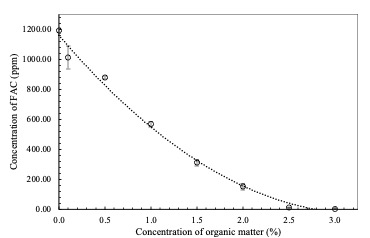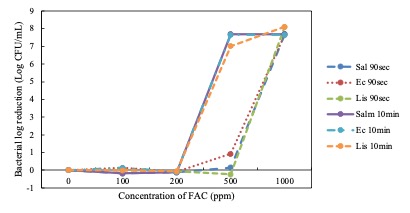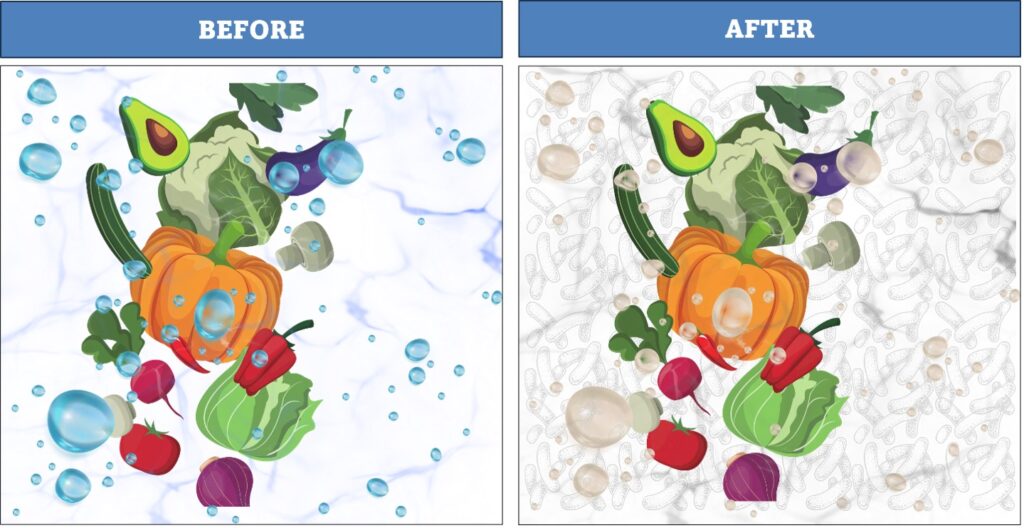Introduction
Ensuring the microbial safety of fresh produce is a critical step in preventing foodborne illnesses and safeguarding public health. Fresh produce is often exposed to contaminants during various stages of production, including growing and harvesting, where it can come into contact with soil, irrigation water, compost and wildlife (Dogan et al., 2023; Rock et al., 2019). One effective way to reduce the risk of contamination is by using sanitizers, including free-available chlorine (FAC), during fresh produce postharvest washing. However, the presence of organic matter can significantly impact the effectiveness of chlorine-based sanitizers (Gombas et al., 2017; Gurtler et al., 2022).
This Extension publication aims to help growers understand the sensitivity of FAC concentrations to soil buildup in postharvest water used for fresh produce washing and why managing organic load is crucial for maintaining effective sanitation practices.
Organic matter buildup can affect free available chlorine concentration
During a dump tank washing procedure, multiple batches of fresh produce are immersed in the same solution, contributing to the buildup of organic matter (Macarisin et al., 2017). Figure 1 demonstrates a rapid decline in FAC concentration as organic matter increases, indicating that even small amounts of organic debris can significantly reduce available chlorine. The fresh chlorine solution started at 1200 ppm FAC, and that value dropped to 0 ppm when the concentration of organic matter increased to 2.5 and 3%, emphasizing the importance of minimizing the organic load to maintain adequate sanitizer levels.
More sanitizer doesn’t always fix the problem
Organic matter, such as soil, leaves, and debris, is commonly present on fresh produce surfaces. When produce is washed, organic matter enters the wash water, which impacts the concentration of FAC. This is because organic matter reacts with free chlorine, decreasing its availability in the solution. This reaction reduces the sanitizer’s efficacy, making the washing process less effective in controlling pathogens. For instance, in our study, adding just 1% vegetable organic matter to chlorinated water (Table 1) caused a significant reduction in FAC levels. At an initial concentration of 100 ppm, the available chlorine dropped to ~1.8 ppm after adding organic matter, illustrating the susceptibility of FAC to organic load.
Table 1. Effect of organic matter addition on FAC concentration
| Free available chlorine concentration (ppm FAC) | |
| Initial FAC concentration (ppm) | FAC concentration after 1% organic matter (ppm) |
| 100 | 1.8±0.26 |
| 200 | 2.3±0.22 |
| 500 | 7.9±0.31 |
| 1000 | 568.33±18.34 |
Organic matter inhibits the ability of FAC to reduce human pathogens in postharvest wash water
Figure 2 illustrates the reduction in Salmonella Typhimurium, E. coli O157:H7, and Listeria monocytogenes concentrations (in log CFU/ml) following the application of different free available chlorine concentrations (0, 100, 200, 500, and 1000 ppm) with 1% vegetable organic matter. At higher FAC concentrations (1000 ppm), complete inactivation of pathogens is achieved within 90 seconds, even when organic matter is present. However, at lower FAC concentrations, pathogen reduction is less effective, especially in the presence of organic matter. For example, at 500 ppm FAC, it takes up to 10 minutes to significantly reduce pathogen levels. This graph underscores the importance of maintaining higher FAC concentrations to ensure rapid and effective microbial inactivation, especially when organic matter is present. These results highlight the impact of organic matter on FAC concentration and pathogen reduction, reinforcing the need for effective organic matter management and proper monitoring of chlorine levels in wash water.
These results have implications for the management of FAC in washing water. Although monitoring FAC levels and organic matter load in washing water may be tedious and expensive, results indicate that maintaining adequate FAC (and product efficacy) is necessary to reduce pathogenic bacteria concentrations.
Practical tips for growers
- Pre-rinse to reduce organic matter: Before the main wash, consider using a pre-rinse step to remove excess soil and debris from produce. This can help reduce the organic load entering the chlorinated wash water.
- Monitor chlorine levels regularly: Use chlorine test strips or a chlorine meter to monitor the FAC concentration in the wash water frequently. Maintaining adequate chlorine levels is essential for effective pathogen control. Always to use the chlorine concentration recommended on the label.
- Replace or filter wash water as needed: Recirculated wash water can accumulate organic matter, reducing the efficacy of FAC. Periodically replace or filter the wash water to control the level of organic material and ensure effective sanitization.
- Optimize water pH: FAC is most effective at a pH between 6.5 and 7.5. Keeping the pH within this range will help maintain effective chlorine activity, especially in the presence of organic matter.
- Lower pH: If the pH is above 7.5, add a food-grade acid, such as citric acid or acetic acid, to bring the pH down. Add the acid slowly while continuously measuring the pH until it reaches the desired range.
- Raise pH: If the pH is below 6.5, add a food-grade base, such as sodium carbonate or sodium bicarbonate, to increase the pH.
Conclusion
Organic matter significantly impacts the concentration and efficacy of free available chlorine in postharvest water. By managing organic load, growers can better maintain adequate levels of FAC and better ensure the safety of their produce. Regular monitoring of FAC concentration, pre-rinsing to reduce organic matter, and managing water quality are essential to optimize the antimicrobial effect of chlorine-based sanitizers. Additionally, managing postharvest water helps growers maintain high produce safety standards, reduce microbial risks, and ensure safe fruit and vegetables for consumers.
References
Dogan, Onay B., Makenzie G. Flach, Markus F. Miller, and Mindy M. Brashears. 2023. “Understanding Potential Cattle Contribution to Leafy Green Outbreaks: A Scoping Review of the Literature and Public Health Reports.” Comprehensive Reviews in Food Science and Food Safety 22(5): 3506–30. DOI: https://doi.org/10.1111/1541-4337.13200.
Gombas, D. et al. 2017. “Guidelines to Validate Control of Cross-Contamination during Washing of Fresh-Cut Leafy Vegetables.” Journal of Food Protection 80(2): 312–30. DOI: https://doi.org/10.4315/0362-028X.JFP-16-258.
Gurtler, Joshua B., Xiaoling Dong, Bin Zhong, and Rensun Lee. 2022. “Efficacy of a Mixed Peroxyorganic Acid Antimicrobial Wash Solution against Salmonella, Escherichia Coli O157:H7, or Listeria monocytogenes on Cherry Tomatoes.” Journal of Food Protection 85(5): 773–77. DOI: https://doi.org/10.4315/JFP-21-368.
Macarisin, Dumitru et al. 2017. “Internalization of Listeria monocytogenes in Cantaloupes during Dump Tank Washing and Hydrocooling.” International Journal of Food Microbiology 257: 165–75. DOI: https://doi.org/10.1016/j.ijfoodmicro.2017.06.018.
Rock, Channah M. et al. 2019. “Review of Water Quality Criteria for Water Reuse and Risk-Based Implications for Irrigated Produce under the FDA Food Safety Modernization Act, Produce Safety Rule.” Environmental Research 172: 616–29. DOI: https://doi.org/10.1016/j.envres.2018.12.050.


